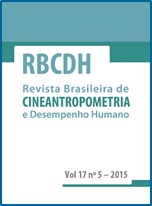Salivary and blood lactate kinetics in response to maximal workload on cycle ergometer
DOI:
https://doi.org/10.1590/1980-0037.2015v17n5p565Abstract
The use of saliva may assist an emerging need for cost, time and invasiveness reduction, and special care involved in the collection of biomarkers, compared to blood tests. The aim of this study was to analyze the lactate kinetics in blood and saliva in response to graded cycle ergometer exercise. In a predictive correlational study, nine healthy male cyclists (24±2 years; 71.3±7.6kg; 170.9±4.7cm) were submitted to a graded exercise protocol, started at 10% of maximal workload (WMAX). Blood and salivary lactate concentrations were measured every 3 minutes during exercise and at the 3rd, 6th, 9th, 15th, 30th and 60th minutes after exercise. To investigate the relationship between salivary and blood lactate, linear regression analysis was applied and the level of significance was set at p<0.05. There was a parallel evolution among the mean values of lactate measured in capillary blood and saliva with increasing workload (R2 adjust. = 0.93, p<0.001). It was concluded that although with different magnitudes, the lactate response during incremental exercise was similar between blood and saliva. Thus, the use of salivary lactate seems to be a noninvasive model for determining the blood lactate response to graded cycle ergometer exercise



